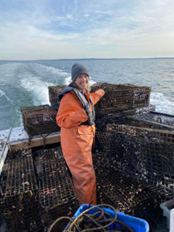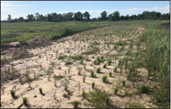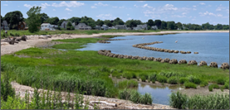Conservation Projects
Conservation at The Maritime Aquarium
The Maritime Aquarium at Norwalk plays a key role in the protection and conservation of Long Island Sound and its watershed. By introducing visitors to the Sound through its living exhibits, marine science and environmental education programs, the Aquarium sparks curiosity in science and fosters the desire to protect and restore the environment. Moreover, The Maritime Aquarium further inspires visitors to appreciate the global environment by connecting the importance of the Long Island Sound to the oceans of the world in a “one ocean” and “all waters are connected” paradigm. The Aquarium engages in local, regional, national, and international conservation projects that support our mission. The Maritime Aquarium at Norwalk also participates in scientific councils and advisory groups to advocate for science-based policy and actions supporting the improved health of Long Island Sound. For example, we are active members of the Aquarium Conservation Partnership, which is a collaboration of 26 aquariums across the country seeking to advance our shared conservation goals.
Maritime Aquarium's Conservation Action Plan: https://publuu.com/flip-book/126446/608608/page/1
Current Projects Include:
Marine Debris Retrieval and Research
The Conservation Department is working with partners from New York and Connecticut on a marine debris recovery program for lost and abandoned lobster traps. Through this program, we are working with local fishers aboard their vessels to recover lobster traps from the bottom of Long Island Sound. Lobster traps can harm the Sound through “ghost fishing,” when the traps continue to catch and kill animals after being lost or abandoned. We are also conducting research to study the species that are using these lost lobster traps as habitat, such as northern star coral.
Salt Marsh Monitoring and Research
Salt marshes, a type of tidal wetland, are among the most productive and threatened ecosystems on Earth. They provide nursery grounds and habitat for wildlife, buffer coastal communities from storm damage, remove nutrients and pollutants from runoff, and store high levels of carbon below ground. Despite the critical role they play, marshes have been subjected to various human impacts, including development, sea level rise and hydrological modifications that have degraded or destroyed these wetlands over many decades. Examples of salt marsh projects in the Conservation Department include:
Marsh Monitoring Network (MMN): Effective salt marsh protection and restoration requires long-term coordinated monitoring to better understand marsh health over time, which will inform sound management decisions. The Marsh Monitoring Network, led by TMA’s Vice President of Conservation, Dr. Sarah Crosby, and coordinated by our Conservation Department with regional partners, is establishing standardized monitoring protocols across Long Island Sound and the broader Northeast. Initial pilot studies, like at Leetes Island in Guilford, will test methods before expanding to other sites that can provide continuous, comparable data. By tracking salt marsh physical, chemical, and biological indicators, the Marsh Monitoring Network supports regional-scale assessments of current marsh condition, change and forecasting in response to climate pressures and other stressors.
Salt Marsh Research: Over 20% of Connecticut’s tidal wetlands and nearly half of New York’s have disappeared in the past 130 years.[sc1][GP2][sc3] Because of the importance of salt marshes, restoration projects are now common across the Sound, aiming to bring back salt marsh ecosystem structure, function, and services. Salt marsh grass restoration plantings often fail due to variables like soil compaction, high water levels, or changing climate conditions. The Aquarium’s Conservation Department aims to understand these failures and work with our partners to improve restoration methods, such as improving soil conditions or planting strategies, to enhance marsh resilience and improve restoration efficacy. In conjunction with nonprofit, academic and governmental partners, the Conservation Department is also conducting field research to understand how natural and restored marshes will respond to climate change. One project seeks to understand how warming and salt marsh genetics play a role in salt marsh resilience, while another project builds upon long-term datasets to monitor the abilities of salt marshes to respond to sea level rise.

Published Research
Structure and Function of Restored and Natural Salt Marshes
https://link.springer.com/article/10.1007/s12237-024-01395-y
Invasive Species Research
The Aquarium partners with local organizations and universities to monitor non-native species in Long Island Sound, particularly since invasive species have an outsized negative impact on ecosystems and economics. Damage from aquatic invasive species cost the U.S. economy about $10 billion in losses each year. In 2023, as part of our lobster trap recovery project, the Conservation Department and our partners discovered the European sea lemon, a species of nudibranch which had never previously been documented in Long Island Sound. Concurrently, our partners identified the lemon drop nudibranch, another new animal to the area. We are conducting research to understand how both of these newly arrived sea slugs, which feed on native sponges, will impact Long Island Sound.
Published Research
Sea Slug Invasion
https://www.reabic.net/journals/bir/2025/3/BIR_2025_Raviraj_etal.pdf
Horseshoe Crab Conservation
Limulus polyphemus, the Atlantic horseshoe crab, is an ancient marine arthropod that has existed for over 450 million years. These animals are important to local ecology, particularly their eggs as a source of food for shore birds, and their blood is currently used in the biomedical industry to test vaccines and injectable drugs (e.g., insulin) for contamination. The Aquarium advocates for transition away from biomedical use of these animals in favor of emerging synthetic alternatives. TMA Conservation staff are currently conducting egg surveys of potential horseshoe crab breeding grounds, in order to identify hotspots for conservation. The Conservation Department has also recently published a global review and analysis of horseshoe crab research using existing datasets to identify priorities for their conservation in the Sound and beyond.
Published Research
Systematic Review of Threats to Horseshoe Crabs and Implications of Conservation of Limulus polyphemus in Long Island Sound, USA
https://www.journals.uchicago.edu/doi/10.1086/737257#_i8
Regional Biodiversity Monitoring Reveals Severe Population Decline of the Atlantic Horseshoe Crabs in Long Island Sound, USA
https://www.nature.com/articles/s41598-025-14910-3#Sec3
Long Island Sound Watershed Water Quality: We are working to improve local water quality through projects including The Unified Water Study, our own Straws By Request campaign, and water quality monitoring in the Long Island Sound Biodiversity Monitoring Program. Our Conservation Department is also currently collaborating with the Interstate Environmental Commission, CT DEEP, and Harbor Watch to lead a new pathogen monitoring network for the Long Island Sound watershed.